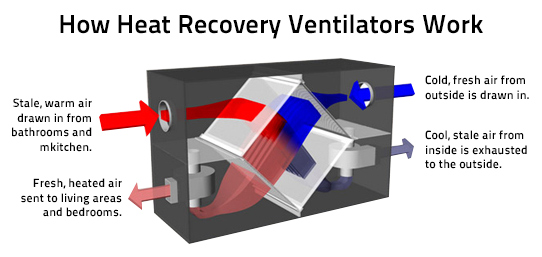How Long Does HRV Perform? Understanding System Lifespan
How Heat Recovery Ventilation Improves Indoor Air Quality and Reduces Power Expenses
Heat Recovery Ventilation (HRV) systems play an important role in improving indoor air quality while at the same time decreasing energy expenditures. By efficiently exchanging stagnant interior air with fresh outdoor air, HRVs help keep optimal humidity and decrease pollutants. Furthermore, their capability to recoup warm from outgoing air reduces the strain on heating and cooling systems. As power costs proceed to climb, understanding the complete possibility of HRV systems becomes significantly crucial for homeowners and services alike.
Recognizing Heat Recovery Ventilation Equipments

Heat recovery ventilation (HRV) systems play a crucial function in improving interior air high quality, particularly in modern-day, energy-efficient structures. These systems are designed to transfer warm from the outgoing stale air to the incoming fresh air, thus lessening power loss while preserving suitable temperature level levels inside your home. HRVs consist of a warmth exchanger, fans, and ductwork, assisting in the continuous circulation of air. By eliminating indoor contaminants and introducing fresh air, HRVs help to stabilize moisture degrees, avoid mold and mildew growth, and minimize allergens. The performance of HRV systems exists in their ability to recoup approximately 80% of the warm from the tired air, promoting energy conservation while making certain a healthy interior environment. Their assimilation is essential in accomplishing sustainable living techniques.
The Relevance of Indoor Air Quality
Indoor air quality (IAQ) is a critical variable influencing the health and wellness of passengers in any type of environment. Poor IAQ can lead to different wellness problems, consisting of respiratory system problems, allergies, and fatigue. Furthermore, it can worsen status quo such as bronchial asthma. Aspects adding to reduced IAQ consist of contaminants from indoor resources like cleansing agents, mold and mildew, and insufficient ventilation. Preserving great IAQ is essential for advertising a risk-free and comfy living or working space. Reliable techniques to enhance IAQ involve regular tracking of air top quality, proper air flow systems, and lessening the use of dangerous substances indoors. By focusing on IAQ, individuals can assure a much healthier atmosphere that promotes performance and total quality of life.
Power Performance Advantages of HRV Systems
Many house owners and structure supervisors are significantly identifying the power performance advantages of warmth recovery ventilation (HRV) systems. By transferring warmth from exhausted interior air to inbound fresh air, HRV systems significantly minimize the energy needed for cooling and heating. This procedure lessens dependence on standard HVAC systems, leading to lower energy expenses. In addition, HRVs aid keep a balanced interior climate, protecting against too much home heating or cooling down needs. The ability to recover approximately 90% of the warmth from outbound air also supports sustainability efforts by minimizing total energy usage. As a result, HRV systems contribute not just to set you back financial savings yet additionally to a lowered carbon impact, straightening with the expanding focus on energy-efficient building methods.
Setup and Upkeep Considerations
The reliable execution of heat recovery ventilation (HRV) systems requires cautious consideration of setup and upkeep factors to guarantee peak performance. Correct positioning of the HRV system is crucial, as it needs to be set up in an area that takes full advantage of airflow while lessening sound interruption. Additionally, ductwork should be properly sized and shielded to prevent energy more loss. Routine upkeep, consisting of filter replacement and system cleaning, is critical to safeguard optimal capability and interior air top quality. Proprietors ought to develop a routine maintenance schedule to determine and resolve prospective issues before they escalate. Cooperation with knowledgeable professionals during both installment review and upkeep phases can improve the longevity and performance of HRV systems, inevitably bring about far better indoor environments and minimized energy costs.
Real-World Applications and Success Stories
Checking out real-world applications of heat healing air flow (HRV) systems reveals their considerable influence on interior air quality and energy effectiveness across different setups. In domestic structures, property owners have reported enhanced air quality, causing fewer allergies and breathing issues. Schools implementing HRV systems have noted enhanced student focus and reduced absenteeism as a result of much better air flow. Business buildings, such as offices and retail spaces, have actually experienced lower energy costs and increased employee performance. A company workplace in a pleasant environment attained a 30% decrease in power expenses after setting up an HRV system. These success tales show that HRV technology not just adds to healthier environments yet likewise gives substantial economic advantages, making it a valuable financial investment for different fields.
Often Asked Concerns
Can HRV Systems Decrease Allergens in Indoor Air?
The performance of HRV systems in decreasing interior irritants mostly depends upon their capacity to filter and exchange air. HRV Heat Recovery Ventilation. By constantly changing stagnant air, these systems can substantially lower irritant levels throughout indoor settings

Exactly How Does Moisture Affect HRV System Efficiency?
Humidity greatly influences HRV system performance; high levels can bring about condensation, reducing efficiency, while low humidity may boost air exchange. Stabilizing moisture is crucial for excellent operation and keeping indoor air high you can try this out quality.
Are HRV Solutions Noisy During Operation?
HRV systems can generate varying noise degrees during operation, relying on their style and setup. Some units operate quietly, while others might create noticeable noise, particularly at higher air movement settings or when poorly maintained.
What Is the Typical Lifespan of an HRV System?

Can HRV Systems Be Used in All Climates?
HRV systems can be used in numerous climates, but their effectiveness may differ - HRV Heat Recovery Ventilation. In extreme temperatures, modifications or extra systems could be necessary to ensure ideal efficiency and convenience while preserving interior air top quality